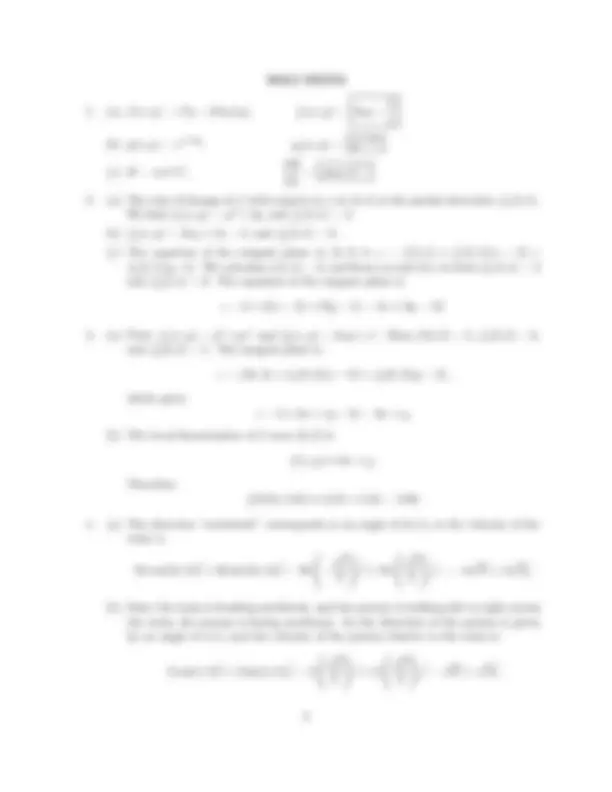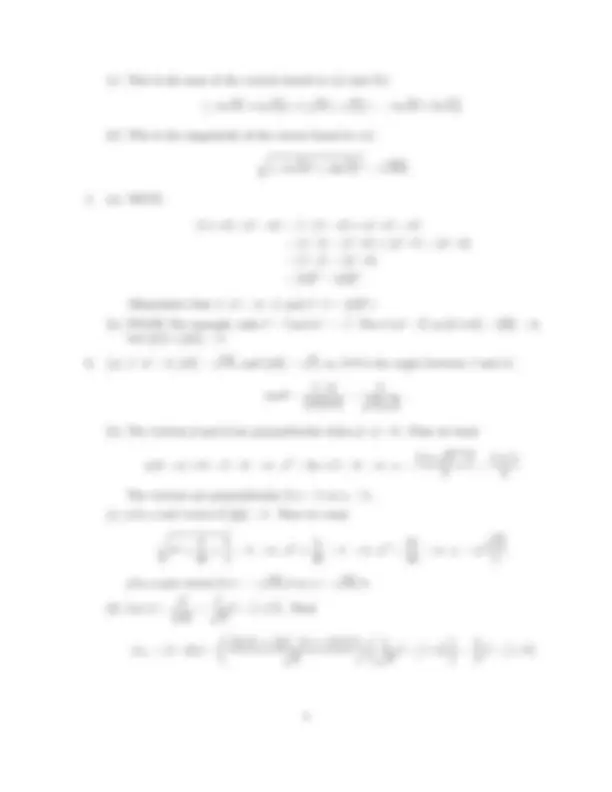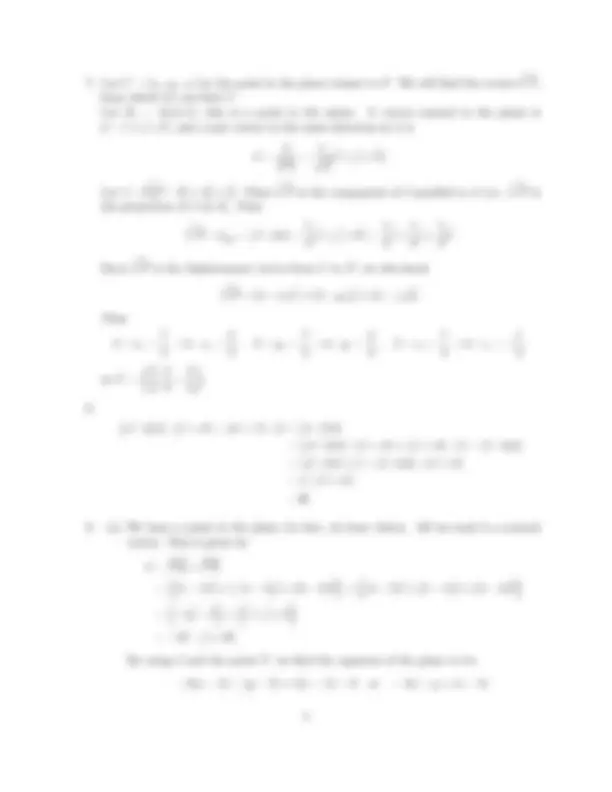





Study with the several resources on Docsity

Earn points by helping other students or get them with a premium plan


Prepare for your exams
Study with the several resources on Docsity

Earn points to download
Earn points by helping other students or get them with a premium plan
Community
Ask the community for help and clear up your study doubts
Discover the best universities in your country according to Docsity users
Free resources
Download our free guides on studying techniques, anxiety management strategies, and thesis advice from Docsity tutors
Practice problems for an exam in calculus iii, specifically focusing on partial derivatives, tangent planes, velocity vectors, dot and cross products, and planes in 3d space. The solutions are also provided, making it a valuable resource for studying or reviewing the course material.
Typology: Exams
1 / 6

This page cannot be seen from the preview
Don't miss anything!




Math 113 – Calculus III Exam 2 Practice Problems Fall 2005
(a) f (x, y) = x
2
y − 3 ln(xy), f x
(x, y) =
(b) g(x, y) = e
x+3y
, g y
(x, y) =
(c) R = πm
a
n
b
,
∂n
f (x, y) = xy
2
(a) What is the rate of change of f with respect to x at the point (3, 1)?
(b) What is the rate of change of f with respect to y at the point (3, 1)?
(c) Find the equation of the plane that is tangent to the graph of f at the point (3, 1).
f (x, y) = xy
2
x .
(a) Find the equation of the plane that is tangent to the graph of f at the point (0, 2).
(b) Use the local linearization of f near (0, 2) to estimate f (0. 04 , 1 .85).
miles per hour from a window on the left side to a window directly across the train on
the right side. (Left and right refer to the sides relative to a person facing the front of
the train.)
Assume that
i points east, and
j points north. Express your answers in terms of these
unit vectors.
(a) What is the velocity vector of the train?
(b) What is the velocity vector of the person relative to the train?
(c) What is the velocity vector of the person relative to the ground?
(d) What is the speed of the person relative to the ground?
2 − ‖ w~‖
2 .
(Briefly explain.)
(b) TRUE or FALSE? For any vectors ~v and w~, ‖~v + w~‖ = ‖~v‖ + ‖ w~‖. (Briefly
explain.)
~v = 3
i + 2
j +
k, w~ =
i −
j +
k, ~p = a~i −
j +
k, ~q = (3 − a)
i − 4
k.
Find:
(a) the cosine of the angle between ~v and w~;
(b) the values of a for which the vectors ~p and ~q perpendicular;
(c) the values of a for which ~p is a unit vector;
(d) the vector that is the component of ~v parallel to w~.
x + y + z = 1,
find the point in the plane that is closest to the point P = (3, 3 , 2).
((~v · ~u)~u) · (~v × w~) − ( w~ × ~v) · (~v − (~u · ~v)~u).
(a) Find the equation of the plane that contains the points P , Q, and R.
(b) Find the area of the triangle formed by the three points.
(c) Find the distance from the plane found in (a) to the point (3, 4 , 5).
the following two planes (which are not perpendicular):
x + 2y + 4z = 1, −x + y − 2 z = 5,
find the equation of a plane that is perpendicular to both of these planes, and that
contains the point (3, 2 , 1).
(c) This is the sum of the vectors found in (a) and (b):
i + 5
j) + (
i +
j) = − 4
i + 6
j.
(d) This is the magnitude of the vector found in (c):
2
(~v + w~) · (~v − w~) = ~v · (~v − w~) + w~ · (~v − w~)
= (~v · ~v) − (~v · w~) + ( w~ · ~v) − ( w~ · w~)
= (~v · ~v) − ( w~ · w~)
= ‖~v‖
2
− ‖ w~‖
2
.
(Remember that ~v · w~ = w~ · ~v, and ~v · ~v = ‖~v‖
2 .)
(b) FALSE. For example, take ~v =
i and w~ = −
i. The ~v+ w~ =
0, so ‖~v+ w~‖ = ‖
but ‖~v‖ + ‖ w~‖ = 2.
14, and ‖ w~‖ =
3, so, if θ is the angle between ~v and w~,
cos θ =
~v · w~
‖~v‖‖ w~‖
(b) The vectors ~p and ~q are perpendicular when ~p · ~q = 0. Thus we want
a(3 − a) + 0 − 2 = 0 =⇒ a
2
− 3 a + 2 = 0 =⇒ a =
The vectors are perpendicular if a = 1 or a = 2.
(c) ~p is a unit vector if ‖~p‖ = 1. Thus we want
a
2
= 1 =⇒ a
2
= 1 =⇒ a
2
=
=⇒ a = ±
~p is a unit vector if a = −
11 /4 or a =
(d) Let ~u =
w~
‖ w~‖
i −
j +
k). Then
~vpar = (~v · ~u)~u =
i −
j +
k)
i −
j +
k)
, y c
, z c
) be the point in the plane closest to P. We will find the vector
−→
from which we can find C.
Let P 0 = (0, 0 , 1); this is a point in the plane. A vector normal to the plane is
~n =
i +
j +
k, and a unit vector in the same direction as ~n is
~u =
~n
‖~n‖
i +
j +
k).
Let ~v =
−→
0
i + 3
j +
k. Then
−→
CP is the component of ~v parallel to ~u (i.e.
−→
CP is
the projection of ~v on ~u). Thus
−→
CP = ~v par
= (~v · ~u)~u =
i +
j +
k) =
i +
j +
k.
Since
−→
CP is the displacement vector from C to P , we also know
−→
CP = (3 − xc)
i + (3 − yc)
j + (2 − zc)
k.
Thus
3 − x c
=⇒ x c
, 3 − y c
=⇒ y c
, 2 − z c
=⇒ z c
so C =
((~v · ~u)~u) · (~v × w~) − ( w~ × ~v) · (~v − (~u · ~v)~u)
= ((~v · ~u)~u) · (~v × w~) + (~v × w~) · (~v − (~v · ~u)~u)
= [(~v · ~u)~u + ~v − (~v · ~u)~u] · (~v × w~)
= ~v · (~v × w~)
vector. This is given by
~n =
i + (− 3 − 1)
j + (0 − 1)
k
i + (2 − 1)
j + (2 − 1)
k
j −
k
i +
j +
k
i −
j + 4
k.
By using ~n and the point P , we find the equation of the plane to be
−3(x − 1) − (y − 1) + 4(z − 1) = 0 or − 3 x − y + 4z = 0.